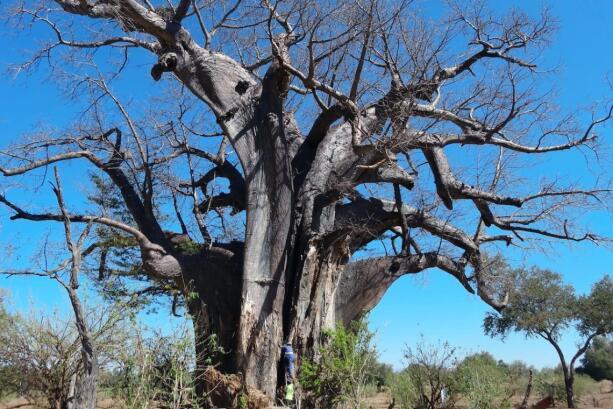Gonarezhou National Park is Zimbabwe’s 2nd largest park and is tucked away in the deep south of the country It forms part of the Great Limpopo Transfrontier Park with Kruger National Park. Gonarezhou is the Shona word which translates as “Place of many Elephants”, and its herds are famous.
‘… wild and untamed – a true remnant of the Africa of old…’
The roads less travelled in Africa lead to exhilarating places and some of the most spectacular scenery in the world. The more I travel in Africa the more I yearn to discover new wild, remote and untouched areas. For me, the African bush is a feast for the senses with different excitement and energy every day.
Many would say that Zimbabwe is rather off the beaten track and is often overlooked because of its political and economic woes but it is a very safe destination to explore and its friendly people are remarkably resilient.

About Gonarezhou
Gonarezhou National Park is Zimbabwe’s 2nd largest park and is tucked away in the deep south of the country on the border of Mozambique. It forms part of the Great Limpopo Transfrontier Park, a peace park that links Gonarezhou National Park with Kruger National Park and the Limpopo National Park in Mozambique. This means that the animals can move safely and freely between the three sanctuaries.
Emerging from a period of uncertainty for tourists, Zimbabwe is one of the most underrated countries that Africa has to offer, and its national parks are amongst the finest, offering something special with a real remote and unspoilt feel about them. Gonarezhou National Park is exceedingly scenic and full of rugged and exciting landscapes. Owing to its vast size, its rough terrain and located away from the main tourist routes, large tracts of Gonarezhou remain as unspoiled wilderness.
Gonarezhou is the Shona word which translates as “Place of many Elephants”, and its herds are famous and well protected in the vast wild sanctuary of 5053 km².
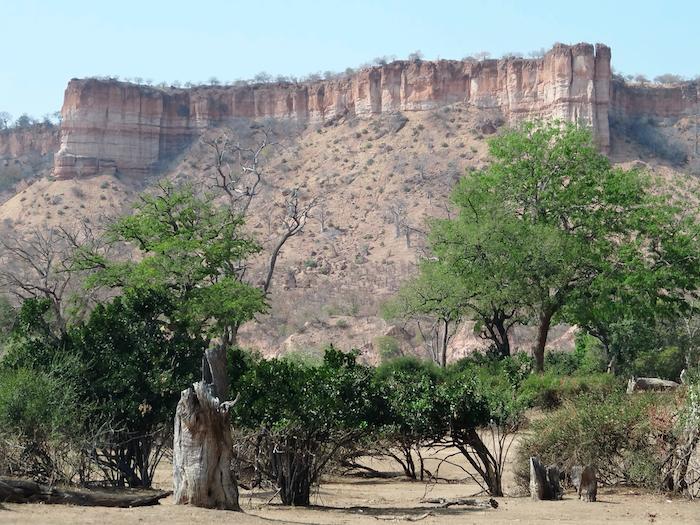
Our journey to Gonarezhou
I travelled with long-time friends on a 10-day safari to explore both the southern and northern sections of the Park. As facilities are limited and roads rough, we set off to enjoy a wild camping adventure with fully self-sufficient 4x4 vehicles, tents, water, medical supplies and all our provisions.
From Johannesburg, we travelled to the most northern part of Kruger National Park. An overnight at Pafuri Gate camp allowed us to cross the border early. We had no idea of the conditions of the rough, deep sand roads or what the water levels of the rivers would be, especially the drive across the Limpopo River which is the border between South Africa and Mozambique. After the South African border, we moved into Mozambique and would eventually cross into Zimbabwe.
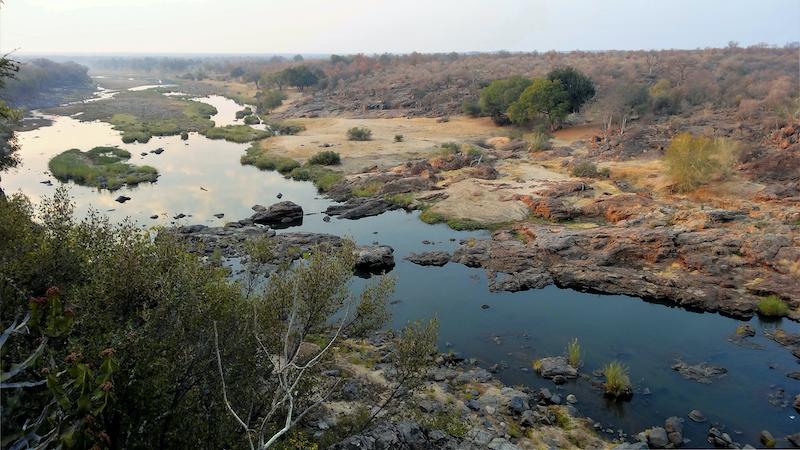
After four hours of soft sand-driving and two river crossing we made our way through Mozambique and arrived at the border town of Chicualacuala. This small town was fascinating with its Portuguese built railway station boasting decorative ceramic tiles from the time when Mozambique was a Portuguese colony. We topped up our supplies to support the very poor community and headed across the Sango border post into Zimbabwe.
There are other less challenging ways to enter the park, depending on where you are travelling from. From Harare, the northern entry gate and headquarters are at Chipindi. The southern headquarters, Mabulata, can also be reached from the Beitbridge border.
How well is Gonarezhou managed?
For decades Gonarezhou was considered too remote and virtually inaccessible to tourists and numerous animals had been shot out by hunters and poachers. Today the Park is managed entirely by the Gonarezhou Conservation Trust using a model agreed upon by the Zimbabwe Parks and Wildlife Authority and the Frankfurt Zoological Society, resulting in the park being very successfully co-managed.
Conservation is alive in Gonarezhou and it is a wonderful success story, in a country, sadly, better known for its difficulties. Wildlife numbers are booming as today there are over 11000 elephants up from 4000 in 1994. The elephants are still very nervous, at times aggressive and wary of people, which is not surprising given the years they endured being hunted, culled and poached. The park has 89 larger and 61 smaller animals. Predators include lion, leopard, cheetah (including the rare king cheetah), spotted and brown hyena and 12 packs of African wild dog. Twenty white rhino will be reintroduced during 2020 as the last of the park’s 200 rhino were shot out 30 years ago. There are also buffalo, giraffe and a range of antelope including kudu, bushbuck, steenbok, nyala, suni, waterbuck and eland. The Park has three main rivers, Mwenenzi, Save and Runde, and these are home to a wide variety of fish and water-based animals like hippos and crocodiles.
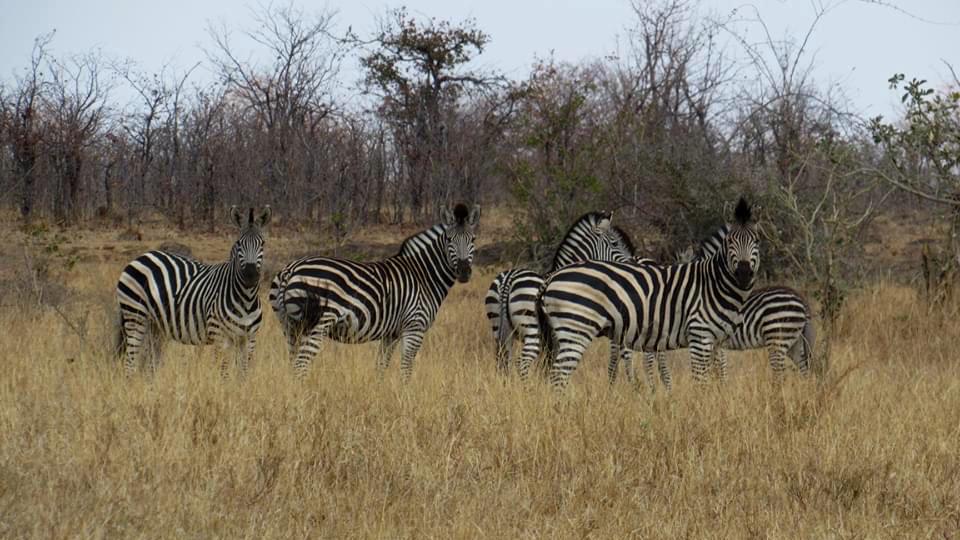
Cheerful and helpful Zimbabwe Park staff impressed us and we found that everything was professionally managed. A detailed map and firewood were available at reception as no wood is allowed to be collected within the park. Although all the main roads are gravel there were signs of continual road maintenance to stop subsidence or wash-aways during the rainy season.
With no cell phones to distract us, we soon settled into the routine of the bush, climbing into our tents when we felt tired and rising with the first calls of the birds before sunrise.
“Come look, two large lions visited us last night and left footprints right through the camp” one of our group called triumphantly early one morning. Although the thought of large lions eyeing our fireside group sent shivers down my spine, the thrill of being in blissful isolation on the water edge of a rustic campsite was exhilarating.

Accommodation at Gonarezhou
There are only three developed campsites offering basic thatch and stone cooking shelters and ablutions. The rest is just GPS coordinates on a map that can only be used by one group at a time. I was pleasantly surprised at the work that had been done at all the remote campsites in providing well prepared elephant-proof long drop toilets. This meant that there was no litter lying around anywhere.
It was at these remote places that we enjoyed wild camping, glorious sunsets and then settled in to enjoy the mysterious sounds of the bush that washed over the campsite every night.
Although not part of the park there are two private luxury camps available, one Chilo Gorge Camp, just outside but on the edge of the Save River, and the other is a mobile camp run by a private guide for single-groups called Gonarezhou Bush Camp.

Landscapes and home to the Baobab
The landscape is as varied as the wildlife: from massive baobabs to sandy forests of ironwood with floodplains and pans to vast mopane forests and large areas of sandveld woodland. The hundreds of giant, ancient, baobabs made a lasting impression and it was obvious that the elephants loved them too. Unfortunately, a lot of damage has been done to these beautiful giant baobabs and many are severely mutilated. The Gonarezhou Conservation Trust started a project to attempt to protect the baobabs in the most iconic areas and where pressure seemed the highest. To date, a total of 200 trees have received some kind of protection by either placing sharp stones around the trees or covering the damaged trunks with mesh wire.
After long, hot and dusty days of driving, I did so enjoy the feel of the cool, refreshing bush showers from our simple shower bag. As dusk fell each night we set up a campfire and shared the meal preparation with the delightful smells of cooking drifting through the night air. We sat in a small circle facing the glowing coals of the fire, our backs to the unknown, reminiscing. Breath-taking stars, more delicious food and an early night saw us through to another early wake-up call.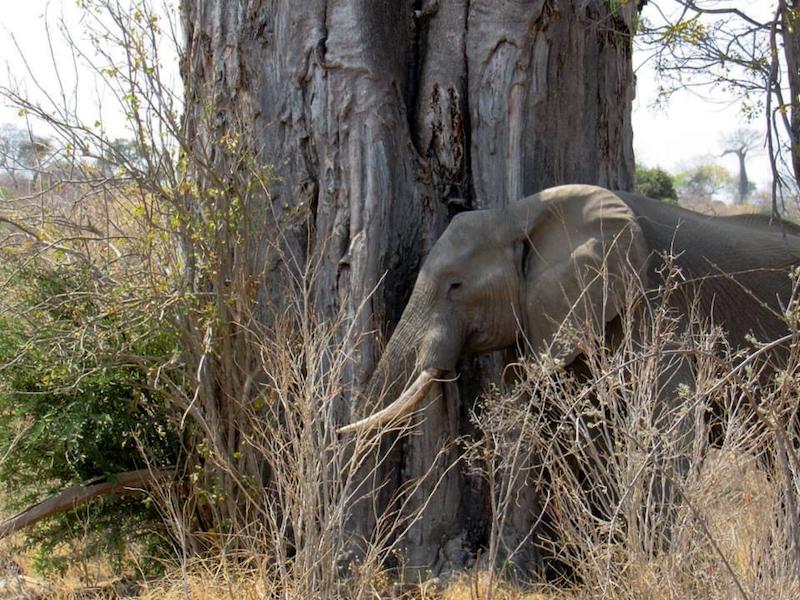
Spectacular wildlife and bird watching at Gonarezhou
Driving around Gonarezhou was exciting with several water crossings, soft sand navigating and at times encounters with large herds of nervous elephant. We sat for ages, with car engines off, taking in the earthy smell of the elephants and watched the family interactions of these gentle giants. A suckling baby, the young males who enjoyed a playful sand bath and the large male with his gentle, amber eyes who kept a careful, watchful eye on us. Just spending time looking at the folds of their skin was mesmerising. Sometimes we had to back off and reverse back the way we had come as they were too skittish for us to pass, even if very slowly. Ears that flapped and loud trumpeting were enough of a warning for us to move on.
Bird viewing in the park is magnificent with over 400 species recorded. If you are a keen birder then the best sightings are to be had from November to April when many of the migratory species make their way south during the European winter. At the pan near the confluence of the two major perennial rivers, the Save and Runde, the birdlife is incomparable.
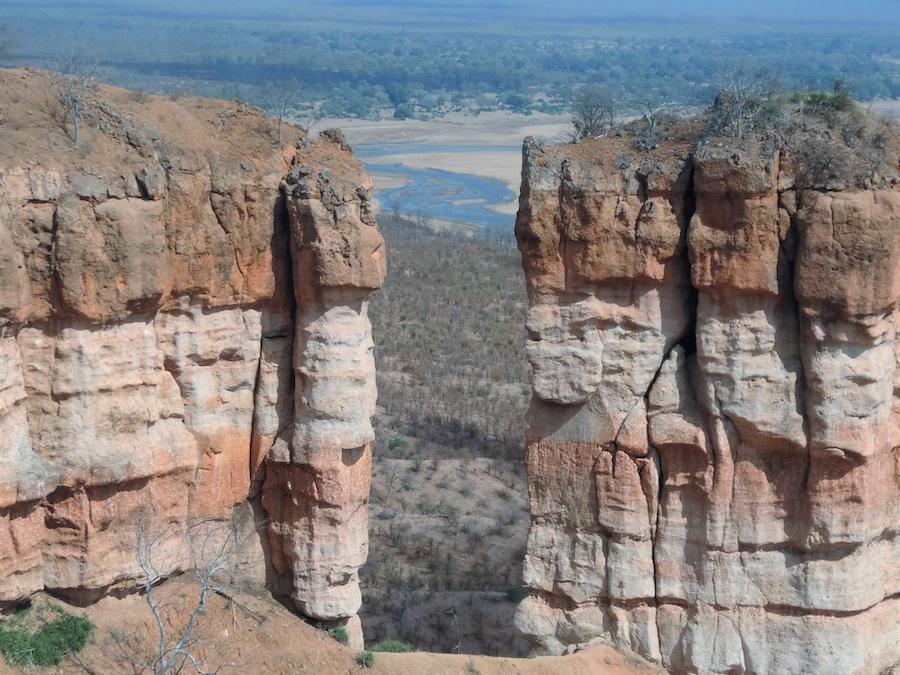
This time, just before dawn, one of our group had spotted three lionesses on the sandbank very close to our camp. As the huge sun burst across the horizon the lionesses watched us with keen interest and had obviously been there awhile. When the warm breeze rustled the trees they sauntered up the bank towards our camp then turned and moved purposely, self-assured and utterly focused into the long grass and away from us. Good strong coffee was needed by all after that exciting encounter and we counted ourselves lucky that such wild places still exist.
The Chilolo Cliffs are a major draw card and also the most photographed feature of Gonarezhou National Park. It is a dramatic sandstone ridge that is about 20 km long and 200m above the wide Runde River. The red and white banded sandstone cliffs seem to change to cream, pink and terracotta with the glow of sunset. The most marvellous of landscapes opened before us as we looked out over the top of the cliffs and down into the gorge. The vastness and magnitude of the place was spectacular and there was not another vehicle around. The lack of tourists is one of the special features of Gonarezhou. From the top we saw elephant making their way down the steep gorge to drink from the river below and I heard that this has happened every evening for hundreds of years.
Access to the park is limited during the rainy season, end of November to April, and most of the campsites are closed because the river crossings needed to reach them are impassable. Treat yourself and explore this remote, rugged and astonishingly beautiful place as it will, without doubt, impress and inspire you. All information on the park can be found on their excellent website - www.gonarezhou.org.
There are few truly wild places in Africa that remain unspoiled by mass tourism and for the time being, Gonarezhou National Park is a special and unique place. The sights, smells and level of remoteness gave us a feeling of exclusivity and allowed us to really appreciate a part of wild and unscathed Africa.
Shop for a cause
Shop on amazon.com | amazon.co.uk

